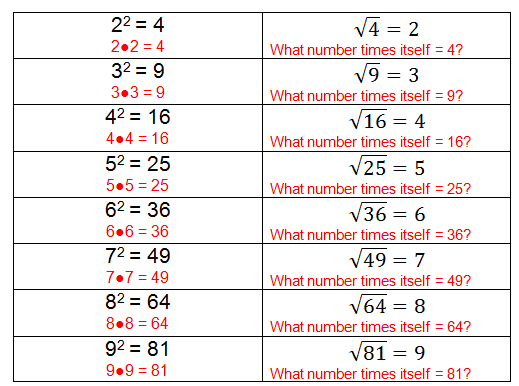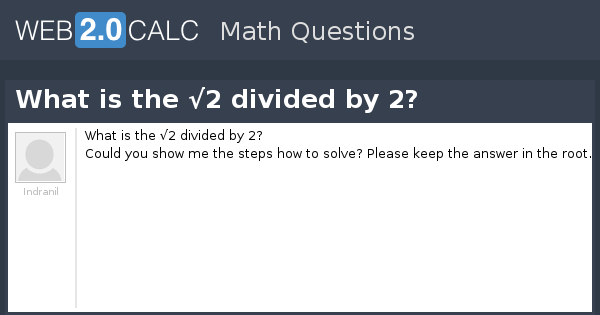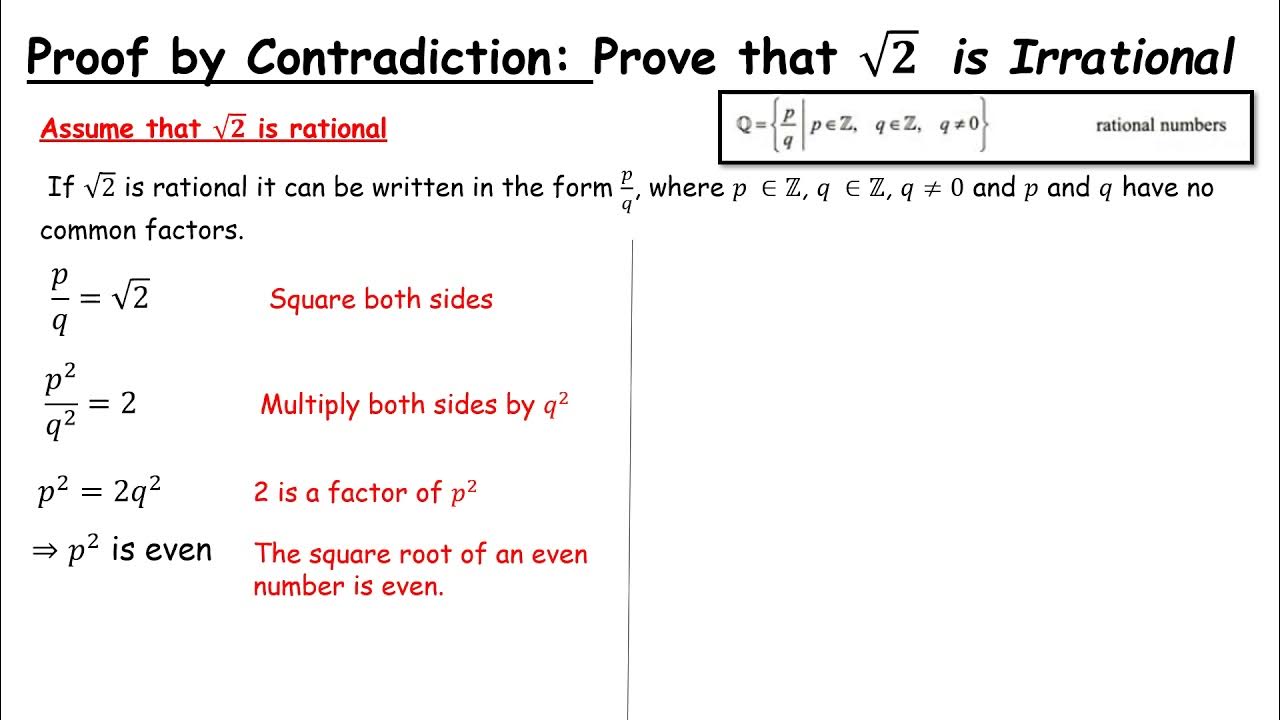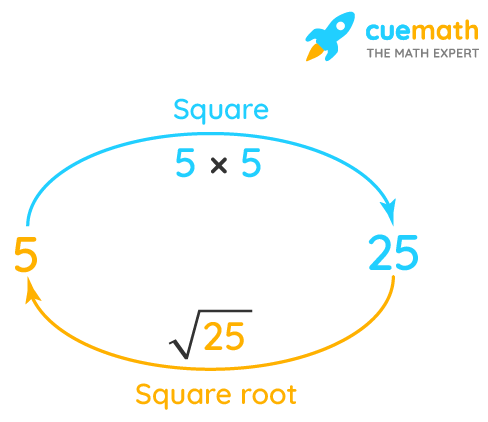Topic square root of 2 fraction: The square root of 2, often denoted as \( \sqrt{2} \), is a fascinating mathematical constant that cannot be exactly expressed as a fraction. This article delves into its properties, historical significance, and various approximations, providing a comprehensive understanding of why \( \sqrt{2} \) continues to intrigue mathematicians and enthusiasts alike.
Table of Content
- Understanding the Square Root of 2 as a Fraction
- Introduction to the Square Root of 2
- Historical Significance of \( \sqrt{2} \)
- Mathematical Properties of \( \sqrt{2} \)
- Irrationality of the Square Root of 2
- Decimal and Fractional Approximations
- Continued Fractions and \( \sqrt{2} \)
- Visual Representation of \( \sqrt{2} \)
- Applications of \( \sqrt{2} \)
- Approximations of \( \sqrt{2} \) in History
- Proofs of Irrationality
- Geometric Interpretation of \( \sqrt{2} \)
- Computational Methods for Approximating \( \sqrt{2} \)
- Modern Applications and Relevance
- YOUTUBE:
Understanding the Square Root of 2 as a Fraction
The square root of 2, often denoted as \( \sqrt{2} \), is a mathematical constant that cannot be exactly expressed as a fraction. This means it is an irrational number. However, for practical purposes, it can be approximated using fractions or decimals.
Key Points about \( \sqrt{2} \)
- \( \sqrt{2} \approx 1.41421356237 \) (decimal approximation)
- \( \sqrt{2} \) cannot be written as an exact fraction of two integers.
- Historically, mathematicians have used fractions to approximate \( \sqrt{2} \).
Historical Approximations
Several fractions have been used throughout history to approximate \( \sqrt{2} \). These include:
- \(\frac{99}{70} \approx 1.4142857\)
- \(\frac{577}{408} \approx 1.4142157\)
- \(\frac{239}{169} \approx 1.4142012\)
Continued Fraction Representation
The square root of 2 can be represented by a continued fraction, which provides increasingly accurate approximations:
$$ \sqrt{2} = 1 + \frac{1}{2 + \frac{1}{2 + \frac{1}{2 + \cdots}}} $$
Approximation Using Rational Numbers
One way to understand the approximation of \( \sqrt{2} \) is through the use of rational numbers:
- Start with an initial guess, for example, 1.4.
- Improve the guess using a fraction, for instance, \( \frac{14}{10} \).
- Refine further with \( \frac{141}{100} \).
- Continue this process to get closer to the true value of \( \sqrt{2} \).
Mathematical Importance
The irrationality of \( \sqrt{2} \) was historically significant as it was one of the first numbers proven to be irrational. This discovery had profound implications for mathematics, challenging the Greeks' notion of numbers.
Visual Representation
The square root of 2 can also be visually represented on the diagonal of a square. If a square has side length 1, the diagonal will have length \( \sqrt{2} \), according to the Pythagorean theorem:
$$ \text{Diagonal} = \sqrt{1^2 + 1^2} = \sqrt{2} $$
Conclusion
While \( \sqrt{2} \) cannot be exactly represented as a fraction, its approximations are useful in various mathematical and practical applications. Understanding these approximations and their historical context enhances our appreciation of this important mathematical constant.

READ MORE:
Introduction to the Square Root of 2
The square root of 2, represented as \( \sqrt{2} \), is a significant number in mathematics. It is the positive number that, when multiplied by itself, equals 2. This concept is fundamental in various fields of mathematics and science.
Key points to understand about \( \sqrt{2} \):
- \( \sqrt{2} \) is an irrational number, meaning it cannot be expressed as a simple fraction.
- Its decimal representation is non-repeating and non-terminating, approximately 1.41421356237.
- The discovery of the irrationality of \( \sqrt{2} \) dates back to ancient Greek mathematicians.
To further explore \( \sqrt{2} \), we can look into its approximations and historical context.
Here is a step-by-step breakdown:
- Historical Background: The concept of \( \sqrt{2} \) was first recognized by the Pythagoreans. The story goes that the discovery of its irrationality was shocking, as it contradicted their belief that all numbers are rational.
- Mathematical Proof: The proof that \( \sqrt{2} \) is irrational is usually demonstrated by contradiction. By assuming \( \sqrt{2} \) can be expressed as a fraction \( \frac{a}{b} \) in simplest terms, we can show that this leads to a contradiction.
- Decimal and Fractional Approximations: Although \( \sqrt{2} \) is irrational, it can be approximated by fractions for practical purposes. Common approximations include \( \frac{99}{70} \) and \( \frac{577}{408} \).
The irrationality of \( \sqrt{2} \) can be represented through a continued fraction:
$$ \sqrt{2} = 1 + \frac{1}{2 + \frac{1}{2 + \frac{1}{2 + \cdots}}} $$
This form highlights the never-ending nature of its exact value, emphasizing why it cannot be precisely captured as a fraction.
Understanding \( \sqrt{2} \) is essential for various mathematical applications, from geometry to advanced calculus, making it a cornerstone of mathematical education and research.
Historical Significance of \( \sqrt{2} \)
The square root of 2, often denoted as \( \sqrt{2} \), holds a significant place in the history of mathematics. Its discovery and implications have influenced various mathematical concepts and theories throughout history.
The Discovery of \( \sqrt{2} \)
The realization that \( \sqrt{2} \) is an irrational number was a groundbreaking event in ancient mathematics. This discovery is attributed to the Pythagoreans, a group of ancient Greek mathematicians and philosophers who believed that all numbers could be expressed as ratios of integers. The legend says that Hippasus, a member of the Pythagorean school, proved the irrationality of \( \sqrt{2} \) while studying the diagonal of a unit square. This revelation was so shocking to the Pythagoreans that it was kept secret because it contradicted their belief in the rational nature of all numbers.
Impact on Greek Mathematics
The proof of the irrationality of \( \sqrt{2} \) had profound implications for Greek mathematics. It challenged the existing notions of number and magnitude, leading to the development of more sophisticated mathematical theories. This realization forced mathematicians to broaden their understanding of numbers and paved the way for the study of irrational numbers and real analysis.
Babylonian Contributions
Before the Greeks, the Babylonians had already approximated \( \sqrt{2} \) with remarkable accuracy. The Babylonian clay tablet YBC 7289, dating back to around 1800-1600 BC, shows an approximation of \( \sqrt{2} \) accurate to five decimal places (approximately 1.41421). This demonstrates the advanced state of Babylonian mathematics and their practical approach to solving problems involving irrational numbers.
Medieval and Renaissance Mathematics
During the medieval period, the work on irrational numbers continued in the Islamic world. Mathematicians like Al-Khwarizmi and Omar Khayyam expanded on the Greeks' work and contributed to algebra and geometry, which included understanding the properties of \( \sqrt{2} \).
In the Renaissance, European mathematicians revisited ancient Greek texts and further developed the study of irrational numbers. This period saw significant advancements in algebra and geometry, setting the stage for modern mathematical analysis.
Modern Implications
Today, \( \sqrt{2} \) is a fundamental concept in various fields of mathematics, science, and engineering. It is crucial in geometry, particularly in relation to the properties of right-angled triangles and the Pythagorean theorem. The number is also essential in computer science, physics, and engineering for calculations involving roots and irrational numbers.
Overall, the historical journey of \( \sqrt{2} \) from a mathematical curiosity to a cornerstone of modern mathematics underscores its enduring significance and the continuous evolution of mathematical thought.
Mathematical Properties of \( \sqrt{2} \)
The square root of 2, denoted as \( \sqrt{2} \), is a unique and intriguing number in mathematics. Here are some of its key mathematical properties:
- Irrationality: \( \sqrt{2} \) is an irrational number, which means it cannot be expressed as a fraction of two integers. Its decimal representation is non-terminating and non-repeating, approximately 1.41421356237.
- Algebraic Identity: The defining property of \( \sqrt{2} \) is that it is a solution to the equation \( x^2 = 2 \). In other words, \( (\sqrt{2})^2 = 2 \).
- Continued Fraction Representation: \( \sqrt{2} \) can be expressed as a continued fraction: \[ \sqrt{2} = 1 + \frac{1}{2 + \frac{1}{2 + \frac{1}{2 + \cdots}}} \] This infinite sequence provides increasingly accurate rational approximations of \( \sqrt{2} \).
- Geometric Significance: In geometry, \( \sqrt{2} \) represents the length of the diagonal of a square with side length 1, derived from the Pythagorean theorem: \( \sqrt{2} = \sqrt{1^2 + 1^2} \).
- Trigonometric Connection: The values of sine and cosine for 45° (or \( \pi/4 \) radians) involve \( \sqrt{2} \): \[ \sin\left(\frac{\pi}{4}\right) = \cos\left(\frac{\pi}{4}\right) = \frac{\sqrt{2}}{2} \]
- Exponentiation: As a positive real number, \( \sqrt{2} \) can be raised to any power. For example, \( (\sqrt{2})^3 = 2\sqrt{2} \) and \( (\sqrt{2})^{-1} = \frac{1}{\sqrt{2}} = \frac{\sqrt{2}}{2} \).
The square root of 2 is essential not only in pure mathematics but also in various applied fields such as physics, engineering, and computer science. Its properties make it a fundamental constant that bridges different areas of mathematical study and practical applications.
Irrationality of the Square Root of 2
The irrationality of \( \sqrt{2} \) has been a significant topic in mathematics since ancient times. Here, we will explore the classic proof by contradiction, which dates back to the time of Euclid.
Proof by Contradiction
We start by assuming the opposite of what we want to prove, namely that \( \sqrt{2} \) is a rational number. This means that it can be expressed as a fraction in its simplest form:
\[ \sqrt{2} = \frac{p}{q} \]
where \( p \) and \( q \) are integers with no common factors (i.e., the fraction is in its simplest form).
- Square both sides of the equation to get:
\[ 2 = \frac{p^2}{q^2} \]
- Rearrange to obtain:
\[ 2q^2 = p^2 \]
This shows that \( p^2 \) is even, because it is equal to \( 2q^2 \) which is even.
- Since \( p^2 \) is even, \( p \) must also be even. Let \( p = 2k \) for some integer \( k \). Substitute this back into the equation:
\[ 2q^2 = (2k)^2 \]
\[ 2q^2 = 4k^2 \]
Divide both sides by 2:
\[ q^2 = 2k^2 \]
- This shows that \( q^2 \) is even, so \( q \) must also be even.
- If both \( p \) and \( q \) are even, they have a common factor of 2, which contradicts our initial assumption that \( \frac{p}{q} \) is in its simplest form.
Since our initial assumption leads to a contradiction, we conclude that \( \sqrt{2} \) cannot be expressed as a fraction of two integers. Therefore, \( \sqrt{2} \) is irrational.
This proof demonstrates the power of logical reasoning and the concept of proof by contradiction. The assumption that \( \sqrt{2} \) is rational leads to an infinite descent, showing that no such fraction can exist, thus proving the irrationality of \( \sqrt{2} \).
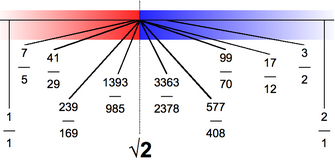
Decimal and Fractional Approximations
The square root of 2 (\(\sqrt{2}\)) is an irrational number, meaning it cannot be expressed as a simple fraction. However, it can be closely approximated using both decimal and fractional representations.
Decimal Approximations
The value of \(\sqrt{2}\) is approximately 1.414213562. This decimal expansion is non-terminating and non-repeating. Some common decimal approximations are:
- 1.4
- 1.41
- 1.414
- 1.4142
- 1.41421
Fractional Approximations
Various fractions can be used to approximate \(\sqrt{2}\). These fractions are derived from continued fraction expansions and other mathematical methods. Some well-known fractional approximations are:
- \(\frac{99}{70} \approx 1.414285714\)
- \(\frac{239}{169} \approx 1.414201183\)
- \(\frac{3363}{2378} \approx 1.414213197\)
Continued Fraction Representation
The continued fraction representation of \(\sqrt{2}\) is an infinite series that provides increasingly accurate fractional approximations. It can be expressed as:
\[
\sqrt{2} = 1 + \frac{1}{2 + \frac{1}{2 + \frac{1}{2 + \cdots}}}
\]
Using this representation, the convergents (fractions that approximate \(\sqrt{2}\)) can be found. The first few convergents are:
- \(\frac{1}{1}\)
- \(\frac{3}{2}\)
- \(\frac{7}{5}\)
- \(\frac{17}{12}\)
- \(\frac{41}{29}\)
Comparison of Approximations
| Fraction | Decimal Value | Approximation Error |
|---|---|---|
| \(\frac{1}{1}\) | 1.000000 | 0.414213562 |
| \(\frac{3}{2}\) | 1.500000 | 0.085786438 |
| \(\frac{7}{5}\) | 1.400000 | 0.014213562 |
| \(\frac{17}{12}\) | 1.416667 | 0.002454104 |
| \(\frac{41}{29}\) | 1.413793 | 0.000420559 |
These fractions show how the approximations become more precise as the continued fraction progresses.
Continued Fractions and \( \sqrt{2} \)
The continued fraction representation of \( \sqrt{2} \) is a unique and fascinating way to approximate this irrational number. Unlike decimal expansions, continued fractions can provide more accurate approximations with fewer terms. The continued fraction for \( \sqrt{2} \) is given by:
\[ \sqrt{2} = 1 + \frac{1}{2 + \frac{1}{2 + \frac{1}{2 + \cdots}}} \]
In general, a simple continued fraction has the form:
\[ a_0 + \frac{1}{a_1 + \frac{1}{a_2 + \frac{1}{a_3 + \cdots}}} \]
For \( \sqrt{2} \), the coefficients \( a_i \) are all 2 after the first term. This pattern can be truncated at any point to obtain rational approximations of \( \sqrt{2} \). These approximations get closer to the actual value as more terms are included. Here are the first few approximations:
- First approximation: \( 1 \)
- Second approximation: \( 1 + \frac{1}{2} = 1.5 \)
- Third approximation: \( 1 + \frac{1}{2 + \frac{1}{2}} = 1.4 \)
- Fourth approximation: \( 1 + \frac{1}{2 + \frac{1}{2 + \frac{1}{2}}} \approx 1.414 \)
These approximations converge to \( \sqrt{2} \) as the number of terms increases.
The sequence of best rational approximations to \( \sqrt{2} \) follows a pattern due to the periodicity in its continued fraction representation. This sequence can be generated using the recurrence relations:
- \( p_{n} = a_n p_{n-1} + p_{n-2} \)
- \( q_{n} = a_n q_{n-1} + q_{n-2} \)
For \( \sqrt{2} \), this simplifies to:
- \( p_n = 2 p_{n-1} + p_{n-2} \)
- \( q_n = 2 q_{n-1} + q_{n-2} \)
Where \( p_0 = 1 \), \( q_0 = 1 \), \( p_1 = 3 \), and \( q_1 = 2 \). These formulas help in finding the next terms in the sequence of best approximations.
Understanding the continued fraction of \( \sqrt{2} \) provides deep insight into the structure and properties of irrational numbers, offering a powerful method for approximating them.
Visual Representation of \( \sqrt{2} \)
The square root of 2, denoted as \( \sqrt{2} \), can be visually represented in several ways, helping to conceptualize this irrational number.
Geometric Representation
A common geometric representation of \( \sqrt{2} \) involves a right triangle. Consider a right triangle where both legs are of length 1 unit:
- Using the Pythagorean theorem, the hypotenuse \( c \) of the triangle can be found as follows: \[ c = \sqrt{a^2 + b^2} = \sqrt{1^2 + 1^2} = \sqrt{2} \]
This hypotenuse visually represents \( \sqrt{2} \) as the diagonal of a square with sides of 1 unit each.
Graphical Representation
Another visual method is to plot the function \( y = \sqrt{x} \) on a graph. The point where \( x = 2 \) on this curve gives the value of \( \sqrt{2} \), which is approximately 1.414.
In this graph, the y-coordinate at \( x = 2 \) corresponds to \( \sqrt{2} \).
Square and Area Representation
A more intuitive approach involves representing \( \sqrt{2} \) using areas. Imagine a unit square with an area of 1 square unit:
- If you form a new square by doubling the area to 2 square units, the side length of this new square will be \( \sqrt{2} \). This demonstrates that the side length of a square with twice the area of a unit square is \( \sqrt{2} \).
These visual methods help to understand the abstract concept of \( \sqrt{2} \) and its properties.
Applications of \( \sqrt{2} \)
The square root of 2 (\( \sqrt{2} \)) has a wide range of applications across various fields. Here are some notable examples:
- Architecture and Engineering: In the design and analysis of structures, \( \sqrt{2} \) is used to calculate the diagonal lengths of squares and rectangles, which is critical for determining stresses and load distributions in buildings and bridges.
- Physics: The constant \( \sqrt{2} \) appears in various physical formulas, such as in the calculation of the root-mean-square (RMS) value of an alternating current (AC) signal, which is essential for electrical engineering and physics.
- Geometry: In geometry, \( \sqrt{2} \) is significant for calculating the diagonal of a square. For a square with side length \( s \), the diagonal length \( d \) is given by \( d = s \sqrt{2} \).
- Finance: In financial calculations, especially in determining volatility and risk assessment, the standard deviation (a measure of dispersion) often involves \( \sqrt{2} \) when calculating the variance of returns on investments.
- Statistics: In statistical analysis, \( \sqrt{2} \) is used in formulas for standard deviation and variance, which are key for understanding data dispersion and making predictions.
- Computer Science: Algorithms in computer science, especially those involving cryptography and data compression, utilize properties of \( \sqrt{2} \) for efficient calculations and secure data transmission.
- Navigation: In navigation, \( \sqrt{2} \) helps in calculating the shortest path between two points in a square grid, which is crucial for route optimization in logistics and robotics.
- Art and Design: The aesthetic appeal of the diagonal lines and symmetry involving \( \sqrt{2} \) can be seen in various artworks and designs, influencing proportions and layouts.
These applications highlight the versatility and importance of \( \sqrt{2} \) across different disciplines, demonstrating its fundamental role in both theoretical and practical contexts.

Approximations of \( \sqrt{2} \) in History
The square root of 2 (\( \sqrt{2} \)) has a rich history of approximations that spans various ancient civilizations. These approximations reflect the mathematical ingenuity and advancements of their times.
Babylonian Approximation
The Babylonians were among the first to approximate \( \sqrt{2} \) accurately. The most famous artifact illustrating this is the tablet YBC 7289, dating back to around 1800-1600 BCE. This tablet shows a value of \( \sqrt{2} \) in sexagesimal (base 60) notation as 1;24,51,10, which is equivalent to approximately 1.414213. This is remarkably close to the true value and demonstrates their advanced understanding of mathematics.
Ancient Greek Approximation
The ancient Greeks also made significant contributions to approximating \( \sqrt{2} \). The mathematician Pythagoras is traditionally associated with the discovery that \( \sqrt{2} \) is an irrational number, meaning it cannot be expressed as a simple fraction. The Greeks used geometric methods and continued fractions to approximate \( \sqrt{2} \) with great precision.
Indian Mathematicians
In ancient India, mathematicians like Aryabhata provided fractional approximations for \( \sqrt{2} \). Aryabhata, in his work "Aryabhatiya" around 499 CE, approximated \( \sqrt{2} \) as \( \frac{577}{408} \), which equals approximately 1.414215686. This shows a deep understanding of the number's value and its importance in various calculations.
Chinese Approximation
Chinese mathematicians, such as Zu Chongzhi during the 5th century, also approximated \( \sqrt{2} \). Zu Chongzhi provided the approximation \( \frac{665}{470} \), which is accurate to six decimal places (1.414213). This reflects the advanced mathematical knowledge present in ancient China.
Medieval and Renaissance Europe
During the Medieval and Renaissance periods, European mathematicians continued to refine the approximation of \( \sqrt{2} \). They employed new mathematical tools and notations that emerged during these times, contributing to a more precise understanding and calculation of irrational numbers.
These historical approximations highlight the widespread and persistent interest in \( \sqrt{2} \) across different cultures and eras. Each civilization contributed to a deeper understanding of this fundamental mathematical constant, paving the way for modern numerical methods and computational techniques.
Proofs of Irrationality
The irrationality of \( \sqrt{2} \) has been known since ancient times, and it remains one of the most significant discoveries in mathematics. Below are several classical proofs demonstrating that \( \sqrt{2} \) cannot be expressed as a rational number.
Proof by Contradiction
One of the most famous proofs of the irrationality of \( \sqrt{2} \) is by contradiction. Here's a step-by-step outline:
- Assume that \( \sqrt{2} \) is rational. Then it can be written as \( \frac{a}{b} \), where \( a \) and \( b \) are integers with no common factors (i.e., the fraction is in its simplest form).
- From the assumption, we have \( \sqrt{2} = \frac{a}{b} \), which implies \( 2 = \frac{a^2}{b^2} \) or \( 2b^2 = a^2 \).
- Since \( a^2 \) is even (because it equals \( 2b^2 \), which is even), \( a \) must also be even. Let \( a = 2k \) for some integer \( k \).
- Substitute \( a \) into the equation: \( 2b^2 = (2k)^2 \), which simplifies to \( 2b^2 = 4k^2 \) or \( b^2 = 2k^2 \).
- This implies \( b^2 \) is also even, and hence \( b \) must be even.
- If both \( a \) and \( b \) are even, they have a common factor of 2, which contradicts the assumption that \( \frac{a}{b} \) is in simplest form.
- Therefore, our initial assumption that \( \sqrt{2} \) is rational must be false. Hence, \( \sqrt{2} \) is irrational.
Geometric Proof
Another way to understand the irrationality of \( \sqrt{2} \) is through geometry, particularly the properties of a right-angled isosceles triangle:
- Consider a right-angled isosceles triangle with legs of length 1.
- By the Pythagorean theorem, the length of the hypotenuse is \( \sqrt{1^2 + 1^2} = \sqrt{2} \).
- If \( \sqrt{2} \) were rational, it could be expressed as a ratio of two integers, which contradicts the geometric construction where no such ratio can precisely describe the hypotenuse length.
Proof Using Continued Fractions
Continued fractions provide another proof of the irrationality of \( \sqrt{2} \). The continued fraction expansion of \( \sqrt{2} \) is:
\[
\sqrt{2} = 1 + \frac{1}{2 + \frac{1}{2 + \frac{1}{2 + \cdots}}}
\]
If \( \sqrt{2} \) were rational, its continued fraction expansion would terminate. However, the expansion for \( \sqrt{2} \) is infinite and non-repeating, indicating its irrational nature.
These proofs not only confirm the irrationality of \( \sqrt{2} \) but also illustrate the richness and diversity of mathematical reasoning used to explore fundamental properties of numbers.
Geometric Interpretation of \( \sqrt{2} \)
The geometric interpretation of \( \sqrt{2} \) can be elegantly demonstrated using basic principles of geometry. One classic method involves the use of a right-angled isosceles triangle. Here is a step-by-step construction:
Start with a line segment \( AB \) of unit length, i.e., \( AB = 1 \).
Construct a perpendicular line segment \( BC \) at point \( B \) such that \( BC = 1 \).
Join points \( A \) and \( C \) to form the hypotenuse \( AC \).
According to the Pythagorean theorem, the length of the hypotenuse \( AC \) will be \( \sqrt{AB^2 + BC^2} = \sqrt{1^2 + 1^2} = \sqrt{2} \).
This right-angled triangle construction visually and mathematically proves that the hypotenuse \( AC \) is indeed \( \sqrt{2} \), providing a clear geometric interpretation of this irrational number.
Another geometric interpretation involves the use of a square:
Draw a square \( ABCD \) where each side is of unit length, \( AB = BC = CD = DA = 1 \).
Draw the diagonal \( AC \) of the square.
Again, by the Pythagorean theorem, the length of the diagonal \( AC \) will be \( \sqrt{AB^2 + BC^2} = \sqrt{1^2 + 1^2} = \sqrt{2} \).
These constructions show the visual and spatial representation of \( \sqrt{2} \) through basic geometric figures. Additionally, this approach underlines the historical and mathematical significance of geometric methods used by ancient mathematicians like the Pythagoreans.
For a more interactive experience, you can explore geometric constructions of \( \sqrt{2} \) using tools like the Wolfram Demonstrations Project, which offers a detailed exploration of geometric principles and their applications.
Interactive Example
Using a compass and straightedge, follow these steps to construct \( \sqrt{2} \):
Draw a horizontal line and mark two points \( A \) and \( B \) such that \( AB = 1 \).
Construct a perpendicular line at \( B \) and mark point \( C \) such that \( BC = 1 \).
Using your compass, draw an arc with \( A \) as the center and \( AC \) as the radius to locate point \( D \) on the extension of line \( AB \).
The length \( AD \) is \( \sqrt{2} \).
These geometric constructions offer an intuitive and visual method to understand the nature of \( \sqrt{2} \) and its properties.
Computational Methods for Approximating \( \sqrt{2} \)
Approximating \( \sqrt{2} \) has been a mathematical challenge tackled through various computational methods over centuries. Here are some of the primary methods used:
1. Babylonian Method (Heron's Method)
The Babylonian method, also known as Heron's method, is an ancient algorithm to approximate square roots. It is an iterative process that improves the guess with each step. Here's how it works:
- Start with an initial guess \( x_0 \) (a rough approximation of \( \sqrt{2} \)).
- Use the iterative formula: \( x_{n+1} = \frac{x_n + \frac{2}{x_n}}{2} \).
- Repeat the iteration until the desired level of accuracy is achieved.
For example, starting with \( x_0 = 1 \):
\[ x_1 = \frac{1 + \frac{2}{1}}{2} = 1.5 \]
\[ x_2 = \frac{1.5 + \frac{2}{1.5}}{2} \approx 1.4167 \]
\[ x_3 = \frac{1.4167 + \frac{2}{1.4167}}{2} \approx 1.4142 \]
2. Continued Fractions
Continued fractions provide an efficient way to approximate irrational numbers. The continued fraction for \( \sqrt{2} \) is:
\[ \sqrt{2} = 1 + \frac{1}{2 + \frac{1}{2 + \frac{1}{2 + \ddots}}} \]
This method generates a sequence of convergents that get progressively closer to \( \sqrt{2} \).
For instance:
\[ \frac{1}{1}, \frac{3}{2}, \frac{7}{5}, \frac{17}{12}, \frac{41}{29}, \frac{99}{70}, \ldots \]
Each of these fractions is a better approximation of \( \sqrt{2} \) than the previous one.
3. Newton's Method
Newton's method, similar to the Babylonian method, is another iterative approach:
\[ x_{n+1} = x_n - \frac{x_n^2 - 2}{2x_n} \]
This formula quickly converges to \( \sqrt{2} \) with a good initial guess.
4. Rational Approximations
Rational approximations involve finding fractions that closely approximate \( \sqrt{2} \). One famous sequence is derived from Pell's equation:
\[ a^2 - 2b^2 = \pm 1 \]
The fractions \(\frac{p}{q}\) from this equation provide good approximations. For instance:
\[ \frac{3}{2}, \frac{7}{5}, \frac{17}{12}, \frac{41}{29}, \frac{99}{70} \]
Each fraction is a closer approximation to \( \sqrt{2} \).
5. Numerical Methods
Modern numerical methods, implemented in computer algorithms, can approximate \( \sqrt{2} \) to a high degree of accuracy. These methods include:
- Binary Search: By continuously narrowing the interval within which \( \sqrt{2} \) lies.
- Series Expansion: Using Taylor series or other infinite series to approximate the value.
Each method has its advantages and applications, from simple hand calculations to complex computer algorithms.

Modern Applications and Relevance
The square root of 2 (\(\sqrt{2}\)) has numerous modern applications across various fields due to its unique mathematical properties. Here, we explore some of the key areas where \(\sqrt{2}\) plays a crucial role:
- Finance: In finance, the square root is used to calculate stock market volatility. The volatility, which measures the degree of variation of a trading price series, involves taking the square root of the variance in stock returns. This helps investors understand and manage risk better.
- Architecture and Engineering: The square root is essential in determining the natural frequencies of structures. For instance, engineers use \(\sqrt{2}\) to assess how buildings and bridges will respond to various forces, such as wind and traffic loads, ensuring stability and safety.
- Statistics: In statistics, standard deviation, a measure of the amount of variation or dispersion in a set of values, is calculated as the square root of the variance. This is vital for data analysis, helping statisticians make informed decisions based on data trends.
- Computer Science: In computer algorithms, especially in fields like cryptography and data encryption, \(\sqrt{2}\) and other square roots are used in generating keys and securing data. Image processing and game physics also employ these mathematical concepts to calculate distances and forces accurately.
- Navigation: The square root function is used in navigation to compute distances between geographical points, aiding in plotting courses for aviation and maritime travel. For example, the Pythagorean theorem, which involves square roots, helps in determining the shortest path between two points on a map.
- Physics: In physics, the square root is used in various formulas, such as calculating the root mean square velocity of gas molecules, which is crucial in understanding the behavior of gases under different conditions.
- Electrical Engineering: Electrical engineers use \(\sqrt{2}\) to calculate the root mean square (RMS) values of alternating current (AC) voltages and currents, which is essential for designing and analyzing electrical circuits.
- Photography: The f-number of a camera lens, which determines the aperture size, is based on the square root of the area of the lens opening. This affects the depth of field and exposure, influencing the quality of photographs.
These examples highlight the widespread importance of the square root of 2 in modern science, technology, engineering, and finance. Its applications continue to be integral in solving complex problems and advancing various fields.
Root 2 - Numberphile
READ MORE:
Một Chứng Minh Rằng Căn Bậc Hai của Hai Là Vô Tỷ


